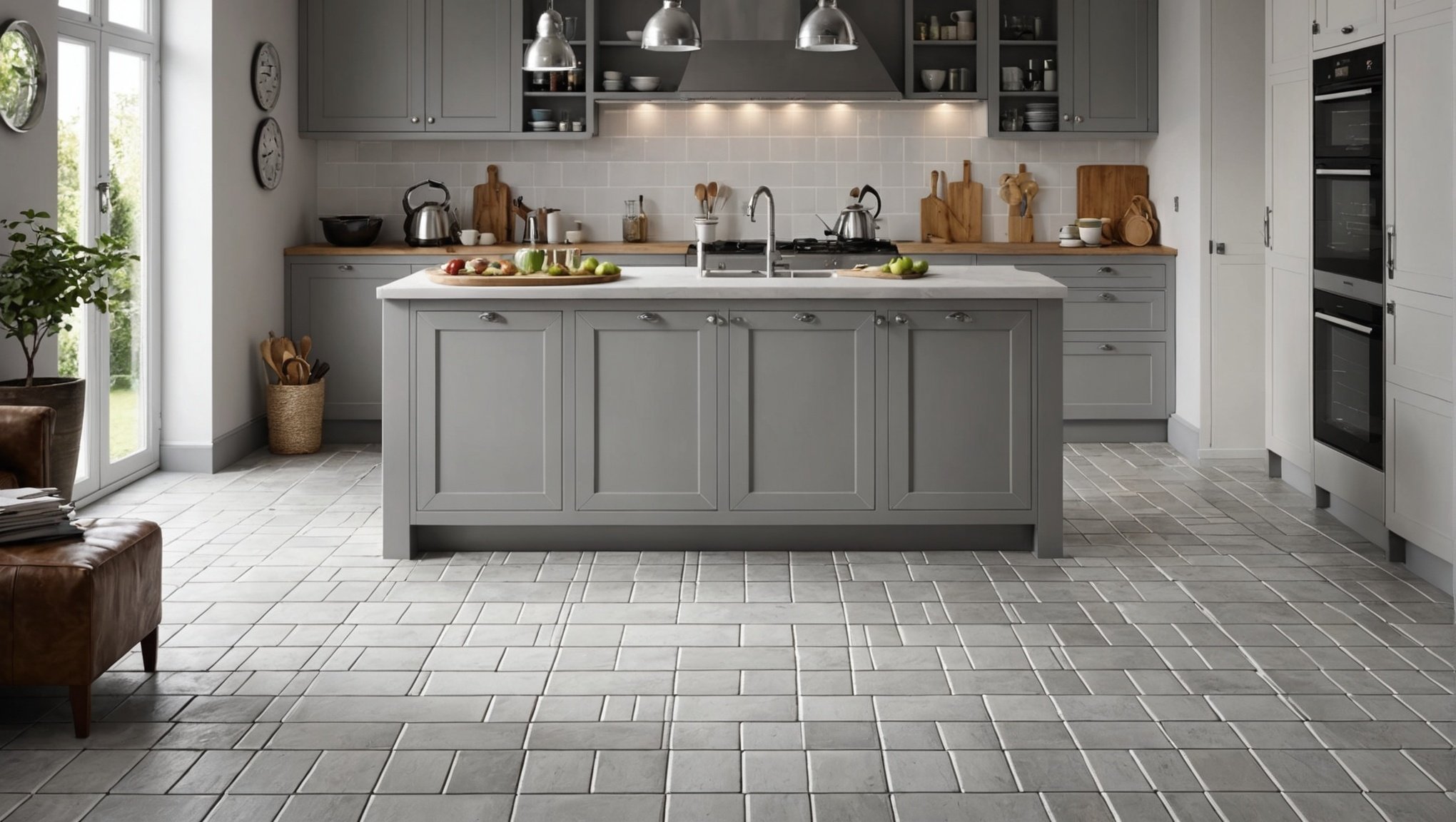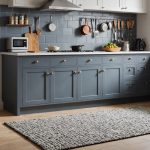Top Underfloor Heating Solutions for Your Ceramic Tiled Kitchen: A Complete Guide
When it comes to enhancing the comfort and luxury of your kitchen, underfloor heating is an excellent option to consider, especially if you have ceramic or porcelain tiles. Here’s a comprehensive guide to help you navigate the best underfloor heating solutions for your ceramic tiled kitchen.
Why Choose Underfloor Heating for Your Kitchen?
Underfloor heating is a fantastic way to create a warm and inviting kitchen environment. Here are a few reasons why it stands out:
Topic to read : Top Strategies for Improving Kitchen Acoustics in Open-Plan Living Spaces
- Ambient Temperature: Tile flooring, particularly ceramic and porcelain, is an excellent conductor of heat. This means that the warmth from the underfloor heating system is efficiently distributed, making the room feel cozier.
- No Need for Rugs or Slippers: With underfloor heating, you can enjoy the warmth of your kitchen floor without the need for rugs or slippers, keeping your space clutter-free and elegant.
- Increased Home Value: Underfloor heating is a premium feature that can significantly increase the value of your home. It’s a luxury add-on that provides years of comfort and convenience.
- Energy Efficiency: When properly installed, underfloor heating systems can be more energy-efficient than traditional heating methods, especially when used in conjunction with a programmable thermostat.
Types of Underfloor Heating Systems
There are several types of underfloor heating systems that you can consider for your ceramic tiled kitchen. Here’s a detailed look at the most common ones:
Electric Underfloor Heating
Electric underfloor heating systems are popular for their ease of installation and flexibility. Here are some key points to consider:
Also read : Top Creative Strategies to Seamlessly Blend a Microwave into Your Contemporary Kitchen Design
- Installation: These systems typically involve laying a heating mat under the tiles. The mat has double-sided tape for easy installation and can be manipulated to fit the desired heating area.
- Cost: Electric underfloor heating systems are generally more affordable to install compared to water-based systems. However, they might be more expensive to run in the long term.
- Efficiency: These systems are efficient, especially when used with a programmable thermostat. They can warm up the floor quickly and maintain a consistent temperature.
- Example: The Warming Systems 120V Electric Tile Radiant Floor Heating Mat is a highly rated option that includes a programmable thermostat and floor sensor. It is easy to install and provides quick and even heating.
Water Underfloor Heating
Water underfloor heating systems, also known as hydronic systems, use warm water-filled tubes to heat the floor.
- Installation: These systems require more complex installation, including the laying of tubes under the floor. However, they can be more energy-efficient in the long run.
- Cost: The initial installation cost is higher, but the operating costs can be lower, especially if you have a boiler or other heat source.
- Efficiency: Hydronic systems are highly efficient, especially in well-insulated homes. They provide a consistent and warm heat that can be maintained at a lower temperature than electric systems.
- Example: For homes with existing boiler systems, hydronic underfloor heating can be a cost-effective and efficient solution. It’s essential to ensure the system is compatible with your flooring and to use insulating paneling to maximize efficiency.
Compatibility with Ceramic and Porcelain Tiles
Both ceramic and porcelain tiles are excellent choices for underfloor heating due to their thermal conductivity.
Ceramic Tiles
- Thermal Conductivity: Ceramic tiles are good conductors of heat, making them suitable for underfloor heating systems. They can efficiently distribute the warmth from the heating mat or tubes.
- Durability: Ceramic tiles are durable and can withstand the heat from underfloor heating systems without compromising their integrity.
- Example: The Daltile Delrona Saltillo Matte 12 in. x 12 in. Glazed Ceramic Floor and Wall Tile is a popular choice that is waterproof, scratch-resistant, and stain-proof, making it ideal for kitchens with underfloor heating.
Porcelain Tiles
- Thermal Conductivity: Porcelain tiles have even better thermal conductivity than ceramic tiles, making them an excellent choice for underfloor heating. They are denser and more durable, which enhances their heat distribution capabilities.
- Durability: Porcelain tiles are highly durable and resistant to moisture, stains, and scratches, ensuring they remain in good condition even with the heat from the underfloor system.
- Example: Porcelain tiles like those from Daltile offer sophisticated durability and a wide range of designs, making them a top choice for kitchens with underfloor heating.
Installation Considerations
Proper installation is crucial for the effectiveness and longevity of your underfloor heating system.
Pre-Installation Checks
Before installing an underfloor heating system, consider the following:
- Floor Type: Ensure that your floor can support the weight and heat of the underfloor heating system. Ceramic and porcelain tiles are generally compatible, but it’s essential to check the manufacturer’s recommendations.
- Insulation: Proper insulation is key to the efficiency of the system. Ensure that the floor is well-insulated to maximize the heat retention and distribution.
- Space Calculation: Calculate the square footage of the area to be heated accurately. This will help you choose the right size of the heating system and ensure even heat distribution.
Installation Process
Here’s a general overview of the installation process:
- Laying the Heating Mat or Tubes: For electric systems, lay the heating mat according to the manufacturer’s instructions. For hydronic systems, lay the tubes in the designated pattern.
- Securing the System: Use adhesive tape or other securing methods to ensure the heating mat or tubes are in place.
- Installing the Flooring: Install the ceramic or porcelain tiles over the heating system, ensuring they are securely fastened and evenly spaced.
- Connecting the Thermostat: Connect the thermostat and any sensors to the heating system. This will allow you to control the temperature and timing of the heat.
Maintenance and Upkeep
To ensure your underfloor heating system and ceramic or porcelain tiles last long, follow these maintenance tips:
Regular Cleaning
- Keep the tiles clean to ensure good thermal conductivity. Regular cleaning will prevent dirt and grime from accumulating and affecting the heat distribution.
- Use a mild cleaner and avoid abrasive materials that could scratch the tiles.
Thermostat Settings
- Use a programmable thermostat to control the temperature and timing of the heat. This will help you save energy and maintain a comfortable temperature.
- Adjust the thermostat settings based on your usage patterns to optimize energy efficiency.
System Checks
- Periodically check the system for any leaks or damage. For hydronic systems, ensure the tubes are intact and not leaking.
- Follow the manufacturer’s guidelines for any maintenance or repairs needed.
Cost Considerations
The cost of underfloor heating systems can vary widely depending on the type, size, and installation complexity.
Material Costs
Here is a rough estimate of the material costs for different types of underfloor heating systems:
| System Type | Material Cost per Square Foot |
|---|---|
| Electric Underfloor | $2-$10 |
| Water Underfloor | $5-$20 |
| Heating Mats | $10-$50 |
| Hydronic Tubes | $15-$30 |
Installation Costs
Installation costs can add significantly to the overall expense. Here are some general estimates:
| System Type | Installation Cost per Square Foot |
|---|---|
| Electric Underfloor | $3-$15 |
| Water Underfloor | $10-$30 |
| Heating Mats | $5-$20 |
| Hydronic Tubes | $15-$40 |
Total Costs
Here is a comprehensive table comparing the total costs, including both material and installation:
| System Type | Total Cost per Square Foot |
|---|---|
| Electric Underfloor | $5-$25 |
| Water Underfloor | $15-$50 |
| Heating Mats | $15-$70 |
| Hydronic Tubes | $30-$70 |
FAQs About Underfloor Heating for Ceramic Tiled Kitchens
Is Underfloor Heating Suitable for Wet Areas?
Yes, underfloor heating can be suitable for wet areas like kitchens, but it’s crucial to ensure the system is designed for wet locations. Electric underfloor heating mats, for example, are often UL listed for use in wet locations.
How Long Does it Take to Warm Up the Floor?
The time it takes to warm up the floor depends on the system and the insulation of the floor. Electric systems can warm up the floor in 15-30 minutes, while hydronic systems may take longer due to the density of the substrate.
Can I Install Underfloor Heating Myself?
While it’s possible to install electric underfloor heating systems as a DIY project, hydronic systems are generally more complex and may require professional installation. Always follow the manufacturer’s instructions and consider professional help if you’re unsure.
Underfloor heating is a fantastic way to enhance the comfort and luxury of your ceramic or porcelain tiled kitchen. By choosing the right system, ensuring proper installation, and following maintenance tips, you can enjoy a warm and inviting kitchen environment all year round.
Key Takeaways
- Choose the Right System: Electric underfloor heating is easy to install and efficient, while hydronic systems offer long-term energy efficiency.
- Ensure Compatibility: Both ceramic and porcelain tiles are excellent choices due to their thermal conductivity.
- Proper Installation: Follow the manufacturer’s instructions and ensure the floor is well-insulated.
- Maintenance: Regular cleaning and thermostat adjustments are key to maintaining the system’s efficiency.
By considering these factors, you can create a warm, comfortable, and luxurious kitchen space that you’ll love spending time in. Whether you opt for electric or hydronic underfloor heating, the benefits of a warm and inviting home are undeniable.






